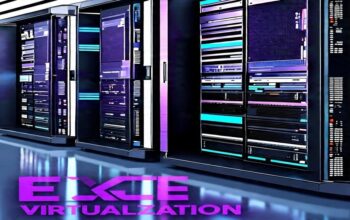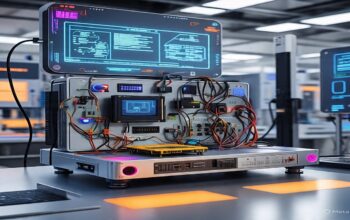In today’s brisk digital world, it is no longer a choice but an obligation to understand a device, discuss software, or explore new gadgets. knowing these abbreviations and terms will help you articulate more confidently. Below is a breakdown of key tech jargon that is simplified for everyone.
Covered Contents
Toggle1. Core Tech Abbreviations
Begin with these common device and connectivity terms.
CPU (Central Processing Unit):
The “command center” of your device, processing instructions and coordinating tasks across all other hardware components.
RAM (Random Access Memory):
Temporary storage of active apps and tasks.
ROM (Read-Only Memory):
Permanent storage for essential data.
SSD-Solid-State Drive:
Faster, more resilient storage than old HDDs.
HDD (Hard Disk Drive):
Traditional mechanical storage.
OTA (Over the Air):
updating the software, firmware, or settings (OS on your phone).
MEC (Multi-Access Edge Computing):
The process at the edge of the network (closer to users) to respond more quickly.
API (Application Programming Interface):
Allows apps/services to talk to each other (social media log-in, etc).
IoT(Internet of Things):
Internet-connected smart devices; fitness trackers, etc.
CNN (Cable News Network):
An AI model for image recognition-facial recognition, etc.
EDA (Exploratory data analysis):
exploring the data and what can be discovered from patterns in it.
DSP (Digital Signal Processing):
Processing signals (audio, video).
2. Networking & Connectivity
Terms to decipher how devices connect and communicate.
IP Address (Internet Protocol Address):
Unique identifier for devices on a network-192.168.1.1, etc.
5G:
The fifth generation of mobile networks, with extreme speeds and low latency.
DHCP (Dynamic host configuration protocol):
It automates networked devices’ configuration
LAN (Local Area Network):
A small network (home Wi-Fi, for instance).
WAN (Wide Area Network):
A large network, such as the Internet.
PAN (Personal Area Network):
Bluetooth connections between personal devices.
MAN (Metropolitan Area Network):
Network spanning a city.
Bluetooth:
Short distance, wireless, tech pairing (for example, headphones).
TCP/IP (Transmission Control Protocol/Internet Protocol):
Rules that govern data transmission over the internet.
MODEM (Modulator-Demodulator):
Converts digital data to be able to send data through specific mediums of conveyance or transmission (from phones).
BLE (Bluetooth Low Energy):
Power-saving Bluetooth for the Internet of Things devices.
Examples: fitness trackers
Wi-Fi (Wireless Fidelity):
To access the internet
SATA (Serial Advanced Technology Attachment):
To attach storage drives (HDD and SSD) to a motherboard
MAC Address (Media Access Control):
an electronic ID address is given to a device on a network.
3. Software & Development
Terms coders should know are also used by app users.
OS (Operating System):
Controls the hardware
Examples: Windows, macOS
UI/UX (User Interface/User Experience):
UI generally deals with the interaction between users and computer systems, software, and applications, and UX deals more generally with a user’s overall experience with a brand, product, or service.
SDK (Software Development Kit):
Apps to create applications for specific operating systems
JSON (JavaScript Object Notation) /XML(Extensible Markup Language):
File types to be used when exchanging information in the app.
CSS (Cascading Style Sheets):
Controls web page appearance.
SQL (Structured Query language):
It’s a programming language used to manage relational databases.
NoSQL (Non-SQL)
Flexible database storage.
4. Security & Privacy
Keep it safe online
HTTP (Hyper Text Transfer Protocol):
Encrypted browsing. It should look for a padlock
2FA (2-factor Authentication):
Another form of login protection (such as getting a code on your phone)
SSL (Secure Sockets Layer):
Encrypts website communication.
TLS (Transport Layer Security) :
The successor to SSL.
WAF (Web Application Firewall)
Protects websites from attacks.
SOC (Security Operations Center) :
Monitors and defends against cyber threats.
Firewall:
Denies any network that isn’t specifically approved access to the network
Phishing:
Tricking the user into entering their information.
VPN (Virtual Private Network):
It encrypts your internet connection.
CRM (Customer relationship management):
This is a technological product that helps companies track and handle customer relationships.
ECDSA (Elliptic Curve Digital Signature Algorithm):
Encryption for secure digital signatures. Used in Bitcoin.
DoS (Denial of Service):
An attack that overwhelms a network/service to crash it.
DDoS (Distributed Denial of Service):
An attack that floods a network.
CIA Triad (Confidentiality, Integrity, and Availability:
The CIA triad is a common model that forms the basis for the development of security systems.
CAPTCHA (Completely Automated Public Turing test to tell Computers and Humans Apart):
Tests to block bots. Example: “Select all traffic lights”.
HMAC (Hash-based Message Authentication Code):
It is a cryptographic authentication technique that uses a hash function and a secret key.
MAC (Message Authentication Code):
Protects messages from alteration.
ACL (Access Control List):
Rules governing access to the network (firewall rules).
5. Emerging Tech: Quantum Computing
Super-powerful computing in the future.
Qubit (Quantum Bit):
A quantum bit may take the values of 0 or 1 and both together also. It’s called a superposition.
Entanglement:
Two qubits can be bound together. Any change in one is instantly made in the other, no matter how far they are apart.
Quantum Supremacy :
A Quantum computer could solve problems a lot faster compared to a computer.
QKD (Quantum Key Distribution)
Secure communication using quantum mechanics.
Quantum Decoherence:
This describes the case in which a quantum state is lost due to disturbances from the environment.
Quantum Gate:
the basic building block in a quantum computing circuit corresponding to the Logic Gate in a classical computing system.
6. Edge Computing: close computation to its data source’s origin.
Edge Computing:
Calculation near the Data Source: computing near smart cameras instead of remitting it over to the Cloud.
Fog Computing:
It is an extension toward the edge closer to the cloud, closer to the network itself.
Latency:
Time lapses while shifting data; lesser latency with this edge computing end.
Edge Node:
Local devices such as routers, or sensors, which itself computes.
Edge AI:
AI algorithms run on edge devices, such as face recognition in real time.
MEC (Multi-Access Edge Computing):
A standard form of edge computing for telecom networks.
7. Cloud & Data Innovations
Terms for storage and large-scale processing.
IBM Cloud:
The set of cloud services provided by IBM, including storage, AI, etc.
AWS (Amazon Web Services):
Amazon’s cloud services.
Cloud Computing:
Remote servers for storage/apps, like AWS or Google Cloud.
CDN (Content Delivery Network):
Accelerates Web Content by spreading the content geographically
Data Lake:
Where raw, unstructured data lives
GCP (GoogPlatformle Cloud ):
Google’s cloud infrastructure.
Azure:
Microsoft’s cloud service.
Kubernetes:
Orchestrating containerized applications at scale (e.g., Docker)
8. Hardware & Connectivity
Terms for the latest devices.
GPU (Graphics Processing Unit):
Used for graphics rendering and parallel calculations (used for gaming and artificial intelligence).
TPU (Tensor Processing Unit) :
Google’s AI processing chip.
NFC (Near Field Communication):
A technology that facilitates communication for contactless payment, just like with Apple Pay.
LiDAR (Light Detection and Ranging):
Utilizing lasers to provide a map. For instance, it is how self-driving vehicles work.
FPGA (Field-Programmable Gate Array):
Customizable hardware chips.
ASIC (Application-Specific Integrated Circuit):
Specialized chips for tasks like Bitcoin mining.
Final Thoughts
Tech lingo may feel like decoding an alien language, but we’re here to decode. Pin this guide, forward it to friends, and refer back to it each time you encounter unfamiliar abbreviations. Know more, and take greater control in our high-tech world!



[b] Portable balancer & Vibration analyzer Balanset-1A [/b]
[b] Description: [/b]
[url=https://allegro.pl/oferta/przenosny-wywazarka-i-analizator-drgan-balanset-1a-kompletny-zestaw-16654413800][img]https://vibromera.eu/wp-content/uploads/2023/09/77-e1693745667801.jpg.webp[/img][/url]
[url=https://www.ebay.com/itm/356202905777] Order on eBay [/url]
Or get a [b]€100[/b] discount on the official website [url=https://vibromera.eu/shop/874/]vibromera.eu[/url] with promo code [b]VB100[/b]
[b]Balanset-1A Device Description[/b]
The Balanset-1A is a compact, dual-channel device designed for balancing and vibration analysis of rotating mechanisms. It is ideal for balancing rotors such as crushers, fans, mulchers, choppers, shafts, centrifuges, turbines, and other rotating machinery.
[b]Essential Features and Capabilities[/b]
[b]Vibrometer Mode[/b]
Tachometer: Precise rotational speed measurement (RPM).
Phase: Determines the vibration signal’s phase angle for accurate analysis.
1x Vibration: Measurement and analysis of the primary frequency component.
FFT Spectrum: Thorough analysis of the vibration signal’s frequency spectrum.
Overall Vibration: Monitoring the total vibration level.
Measurement Log: Stores data for subsequent analysis.
[b]Balancing Mode[/b]
Single-Plane Balancing: Adjusts rotors in one plane to reduce vibration.
Two-Plane Balancing: Dynamic balancing of rotors in two planes.
Polar Diagram: Shows imbalance on a polar chart for precise weight positioning.
Last Session Recovery: Provides the option to resume the last balancing session.
Tolerance Calculator (ISO 1940): Calculates allowable rotor imbalance based on ISO 1940 standards.
Grinding Wheel Balancing: Employs three counterweights for imbalance correction.
[b]Visualizations and Diagrams[/b]
Overall Graphs: Shows overall vibration levels.
1x Graphs: Displays vibration patterns at the main frequency.
Harmonic Graphs: Shows the influence of harmonic frequencies.
Spectral Graphs: Presents the frequency spectrum for detailed examination.
[b]Additional Functions[/b]
Archive: Store and access previous balancing sessions.
Reports: Generate detailed balancing reports.
Rebalancing: Easily repeat the balancing process using saved data.
Serial Production Balancing: Designed for balancing rotors in serial manufacturing.
[b]Package Contents[/b]
The Balanset-1A comes with:
A measurement unit with interface connectivity.
Two vibration transducers.
Optical sensor (laser tachometer) with a magnetic holder.
Digital weighing scales.
Software (laptop not included, available for purchase).
Plastic transport case.
[url=https://www.ebay.com/itm/356202905777] Order on eBay [/url]
Save [b]€100[/b] on [url=https://vibromera.eu/shop/874/]vibromera.eu[/url] with promo code [b]VB100![/b]
Portable balancer & Vibration analyzer Balanset-1A
Description:
Price: €2399
Order on Allegro
Save €100 on vibromera.eu with promo code VB100!
Balanset-1A Device Description
The Balanset-1A is a compact, dual-channel device designed for balancing and vibration analysis of rotating mechanisms. It is ideal for balancing rotors such as crushers, fans, mulchers, choppers, shafts, centrifuges, turbines, and other rotating machinery.
Package Contents
The package contains:
A measurement unit with interface connectivity.
Two accelerometers.
Laser tachometer with magnetic mount.
Electronic balance scales.
Software (computer not included, available as an option).
Transport case.
Price: €2399
Order on Allegro
Save €100 on vibromera.eu with promo code VB100!